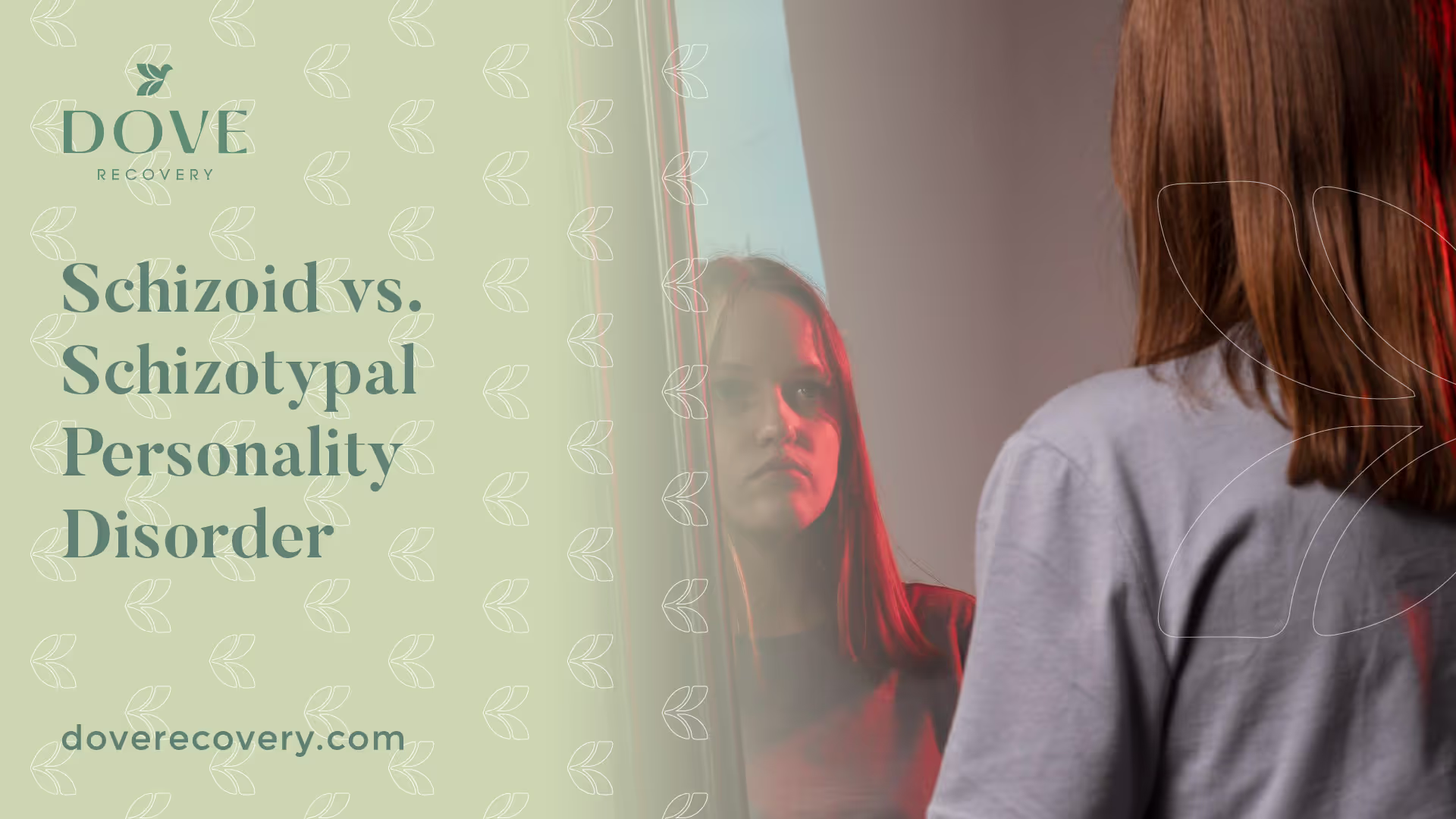Schizoid vs. Schizotypal Personality Disorder

Understanding Personality Disorders
To grasp the nuances of schizoid and schizotypal personality disorders, it is essential to have a foundational understanding of personality disorders as a whole. This section will provide an overview of what personality disorders are and emphasize the importance of differentiating between various disorders.

What Are Personality Disorders?
Personality disorders are a group of mental health conditions characterized by enduring patterns of behavior, cognition, and inner experiences that deviate significantly from societal expectations. These patterns are deeply ingrained and typically manifest across various situations and relationships, causing significant distress and impairment in functioning.
Unlike temporary mood fluctuations or situational reactions, personality disorders are chronic and pervasive, affecting multiple aspects of an individual's life. These disorders often emerge in adolescence or early adulthood and persist into adulthood if left untreated.
There are several types of personality disorders, each with its own distinct features and diagnostic criteria. These disorders are grouped into three clusters based on similarities in symptom presentation:
- Cluster A: Odd or Eccentric Behavior
- Cluster B: Dramatic, Emotional, or Erratic Behavior
- Cluster C: Anxious or Fearful Behavior
Schizoid and schizotypal personality disorders fall within Cluster A, which is characterized by behaviors and thought patterns that can be perceived as odd or peculiar.
The Importance of Differentiating Disorders
Differentiating between personality disorders is crucial for accurate diagnosis and effective treatment planning. While schizoid and schizotypal personality disorders share certain similarities, they also possess distinct features that require careful evaluation.
Accurate diagnosis is essential because it enables mental health professionals to provide tailored interventions and support for individuals with these disorders. Moreover, understanding the specific features of each disorder helps individuals and their loved ones comprehend the challenges they may face and seek appropriate resources.
By recognizing the distinctive characteristics of schizoid and schizotypal personality disorders, mental health professionals can provide targeted interventions to address the specific needs of individuals with these disorders. Differentiating these disorders also ensures that individuals receive appropriate support and treatment plans to enhance their overall well-being.
As we delve further into schizoid and schizotypal personality disorders, it is crucial to examine their unique definitions, characteristics, symptoms, diagnostic criteria, causes, and risk factors. By doing so, we can gain a comprehensive understanding of these disorders and develop a clearer picture of their similarities and contrasts.
Schizoid Personality Disorder
Schizoid Personality Disorder is a complex psychological condition that affects an individual's thoughts, emotions, and behavior. Understanding the definition, characteristics, symptoms, diagnostic criteria, causes, and risk factors associated with this disorder is crucial for comprehensive comprehension.
Definition and Characteristics of Schizoid Personality Disorder
Schizoid Personality Disorder is characterized by a pervasive pattern of detachment from social relationships and a limited range of emotional expression. Individuals with this disorder often prefer to be alone and have difficulty forming close relationships. They may appear indifferent or detached from social interactions, showing little interest in initiating or maintaining personal connections. Their emotional expression may be restricted, and they may seem emotionally cold or distant.
Symptoms and Diagnostic Criteria
To diagnose Schizoid Personality Disorder, mental health professionals refer to the Diagnostic and Statistical Manual of Mental Disorders (DSM-5) criteria. The following criteria must be met for a formal diagnosis:
- Lack of desire for or enjoyment of close relationships, including family.
- Preference for solitary activities and limited interest in social interactions.
- Limited range of emotional expression and difficulty expressing emotions.
- Lack of interest in sexual experiences or intimacy.
- Indifference to praise or criticism from others.
- Emotional detachment or flattened affect.
It's important to note that these symptoms must be persistent and not better explained by another mental health condition.
Causes and Risk Factors
The exact causes of Schizoid Personality Disorder are still not fully understood. However, a combination of genetic, environmental, and neurobiological factors may contribute to its development. Some potential risk factors that have been identified include:
- Family history of personality disorders or schizophrenia.
- Childhood experiences of neglect or emotional detachment.
- Traumatic experiences or social isolation during childhood.
- Neurobiological factors, such as abnormalities in brain structure or neurotransmitter imbalances.
Further research is needed to gain a deeper understanding of the causes and risk factors associated with Schizoid Personality Disorder.
By comprehending the definition, characteristics, symptoms, diagnostic criteria, causes, and risk factors of Schizoid Personality Disorder, individuals can better grasp the complexities of this condition. It is important to consult with a qualified mental health professional for an accurate diagnosis and appropriate treatment.
Schizotypal Personality Disorder
Schizotypal Personality Disorder is a complex and often misunderstood mental health condition. It shares certain similarities with Schizoid Personality Disorder but also has distinct features that set it apart. In this section, we will explore the definition, characteristics, symptoms, diagnostic criteria, causes, and risk factors associated with Schizotypal Personality Disorder.
Definition and Characteristics of Schizotypal Personality Disorder
Schizotypal Personality Disorder is characterized by a pattern of social and interpersonal deficits, along with eccentric behavior and unusual beliefs. Individuals with this disorder often experience discomfort in close relationships and struggle with social anxiety. They may exhibit odd or peculiar behaviors, have distorted thinking patterns, and display a reduced capacity for forming meaningful connections with others.
People with Schizotypal Personality Disorder may also exhibit cognitive or perceptual distortions, such as magical thinking, unusual beliefs, or experiencing illusions. It's important to note that these experiences are different from the hallucinations and delusions seen in psychotic disorders like schizophrenia.
Symptoms and Diagnostic Criteria
To meet the diagnostic criteria for Schizotypal Personality Disorder, an individual must exhibit at least five of the following symptoms:
- Ideas of reference (believing that unrelated events are somehow connected to oneself).
- Odd beliefs or magical thinking that influences behavior and is inconsistent with cultural norms.
- Unusual perceptual experiences, such as hearing voices or having bodily illusions.
- Odd thinking and speech, including vague or circumstantial language.
- Suspiciousness or paranoid ideation.
- Inappropriate or constricted affect (emotional expression).
- Behavior or appearance that is eccentric or peculiar.
- Lack of close friends or confidants.
- Social anxiety and discomfort.
These symptoms must be persistent and cause significant distress or impairment in social, occupational, or other important areas of functioning.
Causes and Risk Factors
The exact causes of Schizotypal Personality Disorder are not fully understood. However, a combination of genetic, environmental, and neurobiological factors is believed to contribute to its development. Individuals with a family history of schizophrenia or other psychotic disorders may have an increased risk of developing Schizotypal Personality Disorder.
Other potential risk factors include childhood trauma, disruptions in early development, and social isolation. These factors can potentially interact with genetic vulnerabilities and affect the development of the disorder.
Understanding the definition, symptoms, and diagnostic criteria of Schizotypal Personality Disorder is essential in distinguishing it from Schizoid Personality Disorder. In the next section, we will explore the similarities and contrasts between these two related disorders to gain a deeper understanding of their distinctions.
Similarities between Schizoid and Schizotypal Personality Disorder
When examining schizoid and schizotypal personality disorders, it becomes evident that these two disorders share certain features and overlapping traits, leading to challenges in diagnosis and differentiation.
Shared Features and Overlapping Traits
Both schizoid and schizotypal personality disorders fall within the cluster A personality disorders as defined by the Diagnostic and Statistical Manual of Mental Disorders (DSM-5). They share some common characteristics, including social withdrawal and difficulties in interpersonal relationships. Individuals with both disorders tend to prefer solitude and often experience limited emotional expression.
Moreover, individuals with schizoid and schizotypal personality disorders may exhibit peculiar or eccentric behavior, which can include unconventional beliefs, odd speech patterns, and perceptual distortions. These shared features can contribute to the diagnostic challenges faced by mental health professionals.
Challenges in Diagnosis and Differentiation
Differentiating between schizoid and schizotypal personality disorders can be complex due to the overlapping symptoms and traits. The similarities in social withdrawal and eccentric behavior can make it difficult to distinguish one disorder from the other, especially when relying solely on surface-level observations.
Thorough clinical assessment, including a comprehensive evaluation of the individual's history, symptoms, and functioning, is necessary to differentiate between the two disorders. Mental health professionals utilize standardized diagnostic criteria and consider the severity, duration, and impact of symptoms to arrive at an accurate diagnosis.
Additionally, it is not uncommon for individuals to exhibit traits of both disorders simultaneously or for symptoms to evolve over time. This further complicates the diagnostic process and underscores the importance of a comprehensive assessment.
To better understand the contrasting aspects of schizoid and schizotypal personality disorders, let's explore the key differences in symptoms and behaviors as well as variations in social functioning and relationships.
Contrasts between Schizoid and Schizotypal Personality Disorder
While Schizoid Personality Disorder (SPD) and Schizotypal Personality Disorder (STPD) share some similarities, they also have distinct differences in symptoms, behaviors, social functioning, and treatment approaches.
Key Differences in Symptoms and Behaviors
Schizoid Personality Disorder (SPD): Individuals with SPD typically exhibit a pervasive pattern of detachment from social relationships and a limited range of emotional expression. They may appear emotionally cold or indifferent and prefer solitary activities. People with SPD generally do not experience significant distortions in thinking or have unusual beliefs.
Schizotypal Personality Disorder (STPD): In contrast, individuals with STPD often display eccentric behaviors, peculiar thoughts, and unusual beliefs. They may experience perceptual distortions, such as magical thinking or illusions. Unlike individuals with SPD, those with STPD may have transient psychotic-like symptoms but do not fully meet the criteria for a psychotic disorder.
Variations in Social Functioning and Relationships
Schizoid Personality Disorder (SPD): Individuals with SPD tend to have difficulty forming and maintaining close relationships. They often prefer solitude and may struggle with social cues, making it challenging to connect with others on an emotional level. Their limited emotional range and detachment can contribute to a sense of social isolation.
Schizotypal Personality Disorder (STPD): People with STPD may desire social connections but often struggle with interpersonal relationships due to their eccentric behavior, odd beliefs, and social anxiety. They may have a limited number of close relationships and may feel socially isolated or misunderstood.
Treatment Approaches for Each Disorder
Schizoid Personality Disorder (SPD): Treatment for SPD primarily focuses on improving the individual's quality of life and helping them develop coping strategies to manage social interactions. Psychotherapy, such as cognitive-behavioral therapy (CBT) or psychodynamic therapy, may be beneficial in addressing social skills deficits and exploring underlying emotional issues.
Schizotypal Personality Disorder (STPD): Treatment for STPD often involves a combination of therapy and medication. Psychotherapy, particularly cognitive-behavioral therapy (CBT) and dialectical behavior therapy (DBT), can help individuals manage symptoms, develop social skills, and challenge distorted thinking patterns. In some cases, medication may be prescribed to address specific symptoms, such as anxiety or depression.
Understanding the contrasts between SPD and STPD is crucial for accurate diagnosis and appropriate treatment planning. Although they share some common features, the distinct differences in symptoms, social functioning, and treatment approaches highlight the importance of a comprehensive assessment by a mental health professional.
Conclusion
In conclusion, Schizoid Personality Disorder and Schizotypal Personality Disorder are complex psychological conditions that can significantly impact an individual's thoughts, emotions, and behavior. While these two disorders share some similarities, they also have distinct differences in symptoms, behaviors, social functioning, and treatment approaches. Recognizing the contrasting aspects of each disorder is crucial for accurate diagnosis and appropriate treatment planning.
By comprehending the definition, characteristics, symptoms, diagnostic criteria, causes, and risk factors associated with these disorders, individuals can better grasp their complexities. It is important to seek help from a qualified mental health professional for an accurate diagnosis and appropriate treatment plan. With proper care and support, individuals with schizoid or schizotypal personality disorders can lead fulfilling lives.
Sources:
- https://www.ncbi.nlm.nih.gov/pmc/articles/PMC2992453/
- https://www.charliehealth.com/post/schizoid-vs-schizotypal-personality-disorders#:~:text=People%20living%20with%20schizoid%20personality,interaction%20due%20to%20their%20eccentricities.
- https://www.mayoclinic.org/diseases-conditions/schizoid-personality-disorder/symptoms-causes/syc-20354414
